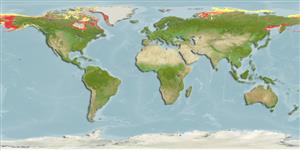Environment: milieu / climate zone / depth range / distribution range
Ecología
marino demersal; rango de profundidad 0 - 94 m (Ref. 50550), usually 30 - 46 m (Ref. 48978). Polar; 83°N - 40°N, 136°E - 42°W
Western Atlantic: Arctic Ocean to southern Labrador, Canada and western Greenland. North Pacific: Japan (Ref. 559) and Alaska (Ref. 11366).
Tamaño / Peso / Age
Maturity: Lm ? range ? - ? cm
Max length : 30.0 cm TL macho / no sexado; (Ref. 7251)
Short description
Claves de identificación | Morfología | Morfometría
Espinas dorsales (total) : 80 - 83; Espinas anales: 2; Radios blandos anales: 38 - 42; Vértebra: 87 - 90.
Facultative air-breathing (Ref. 126274); Entirely subtidal (Ref. 48978). Benthic; feeds on crustaceans and worms (Ref. 58426).
Life cycle and mating behavior
Maturities | Reproducción | Spawnings | Egg(s) | Fecundities | Larva
Robins, C.R. and G.C. Ray, 1986. A field guide to Atlantic coast fishes of North America. Houghton Mifflin Company, Boston, U.S.A. 354 p. (Ref. 7251)
IUCN Red List Status (Ref. 130435)
Threat to humans
Harmless
Human uses
Herramientas
Special reports
Download XML
Fuentes de Internet
Estimates based on models
Preferred temperature (Ref.
123201): -1.4 - 2.8, mean 0 °C (based on 367 cells).
Phylogenetic diversity index (Ref.
82804): PD
50 = 0.5005 [Uniqueness, from 0.5 = low to 2.0 = high].
Bayesian length-weight: a=0.00162 (0.00068 - 0.00388), b=3.19 (2.99 - 3.39), in cm total length, based on LWR estimates for this (Sub)family-body shape (Ref.
93245).
Nivel trófico (Ref.
69278): 3.3 ±0.39 se; based on food items.
Resiliencia (Ref.
120179): Medio, población duplicada en un tiempo mínimo de 1.4-4.4 años (Preliminary K or Fecundity.).
Fishing Vulnerability (Ref.
59153): Low vulnerability (20 of 100).
